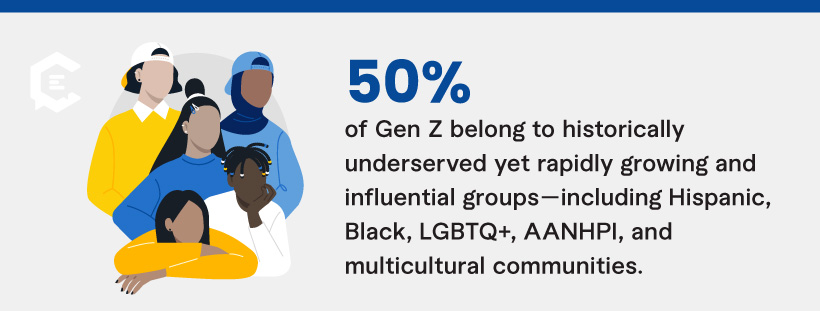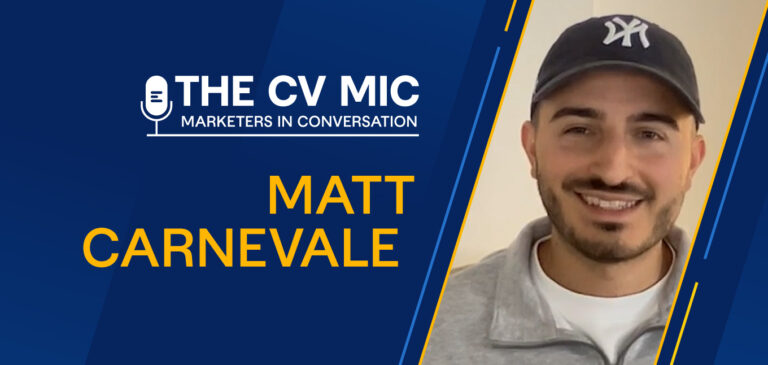Buzzwords come and go, but cultural intelligence isn’t one of them.
For Jessica Germain, VP of Marketing at My Code, it’s not a fleeting trend or a DEI checkbox. It’s a foundation. One that drives connection, informs strategy, and helps brands speak to the audiences shaping our collective future.
In this episode of CV MIC (Marketers in Conversation), Jessica joins ClearVoice’s Taylor Moon to talk about redefining cultural marketing, building trust with growth audiences, and creating content that doesn’t just reflect identity but respects it.
From Dot-Com Hustle to Data-Driven Mission
Jessica’s marketing career didn’t begin with a vision of multicultural strategy or storytelling. It started with product marketing and RFPs. Early roles at companies gave her a crash course in what advertisers wanted and what they didn’t. She honed her skills, learning how to translate product features into real value for partners.
But it wasn’t until she joined the then-startup H Code (now My Code) that things clicked in a different way. Working in a WeWork with a small team, she helped build the brand from the ground up. That included defining their value to advertisers, expanding offerings from Hispanic to Black and AANHPI audiences, and launching what would eventually become their Intelligence Center — a data hub built to track, understand, and serve multicultural communities.
Those early experiences weren’t just nostalgic; they were strategic. “We figured out that we had the secret sauce to get different advertisers involved,” Jessica explained. And that “sauce” wasn’t just representation. It was relationships, rooted in community and backed by real data.
Who Are Growth Audiences and Why Do They Matter?
The term “growth audiences” might sound like a marketing catchphrase, but at My Code, it has a very specific definition: U.S. populations that are expanding in number and cultural influence, yet historically underserved by mainstream media and advertising.
That includes Hispanic, Black, LGBTQ+, AANHPI, and increasingly multicultural Gen Z consumers. Jessica points out that 50% of Gen Z falls into one or more of these groups — and their expectations are different. They want to see themselves represented authentically. They care about values, not just value. And they’re more attuned to when brands miss the mark.
But growth audiences aren’t defined solely by ethnicity or gender identity. My Code takes a more expansive approach, accounting for cultural touchpoints like music, food, entertainment, family structure, and lived experience. A multicultural Gen Z household, a bilingual millennial mom, or a Black gamer passionate about K-pop — all fall into the world of nuanced audience mapping My Code specializes in.
For marketers, this requires moving beyond static personas or outdated assumptions. “Culture doesn’t just come from your racial or ethnic background,” Jessica shared. “It’s everything that makes you, you.”
Culture as a Strategy, Not a Seasonal Play
When asked where brands often go wrong, Jessica is candid: they try to blanket everyone. Campaigns might check the boxes of representation, but still feel hollow — because they’re not rooted in lived experience or authentic insight. Diversity becomes decorative instead of strategic.
She challenges brands to think upstream: Who’s in the room when the ideas are being formed? Are the right voices being heard early in the process — or just added in post-production?
That’s why My Code invests heavily in its publisher network and owned media brands. These teams aren’t just content creators; they’re culture reporters. They help surface what’s trending, what’s changing, and what matters to the people they serve — long before it makes its way into a marketing deck.
Treating culture like a campaign moment misses the mark. Building it into your strategy, however, can move the needle in ways seasonal tactics never could.
Content is Still King… When It’s Created with Purpose
Content is everywhere, but relevance is rare. My Code treats content not just as deliverables, but as “the microphone of the community.” And it’s a powerful one when used right.
When campaigns are backed by insight, created by those who understand the nuance, and distributed where those audiences actually are, content becomes connective. It sparks conversation, drives emotion, and earns trust — even in a world full of scrollable distractions.
And this isn’t limited to brand campaigns. It extends to editorial initiatives, thought leadership, and even internal communications. For My Code, content is the vehicle for everything — but only when it’s grounded in authenticity and built with intention.
Data Isn’t Just Insight; It’s Opportunity
My Code’s Intelligence Center is more than a research function. It’s a source of real-time perspective into how people think, behave, buy, vote, and connect. Current studies span entertainment habits, streaming behaviors, mental health perspectives, and more, all filtered through a multicultural lens.
This data doesn’t live in a vacuum. It informs brand messaging, product development, media buying, and even political strategy. As Jessica explained, brands come to them not just for campaign execution, but for help identifying what they’ve missed — the blind spots in who they’re speaking to, and how.
From streaming bundles to theatrical releases to mental health sentiment shifts post-COVID, the insights coming out of My Code aren’t just informing marketing, they’re shaping how companies build for the future.
Closing Thoughts: Where Culture and Content Converge
What Jessica and her team at My Code offer isn’t just marketing — it’s a model. One that centers culture, listens to the people shaping it, and creates content that reflects the nuance of real communities.
As our demographics shift and digital attention splinters, culturally fluent storytelling isn’t a “nice to have.” It’s a business imperative.
Ready to turn insight into connection and content into impact? Connect with a ClearVoice content strategist to get started. And stay tuned for more interviews.
Explore more from CV MIC:






